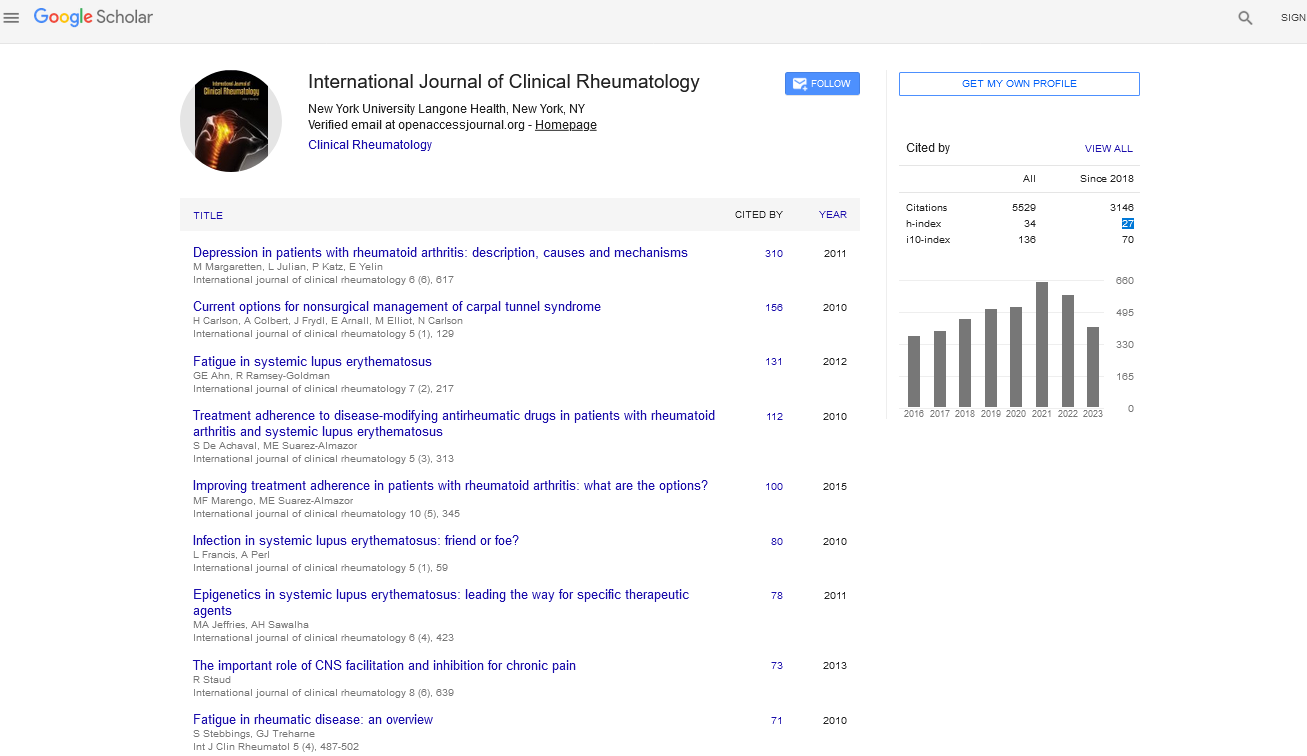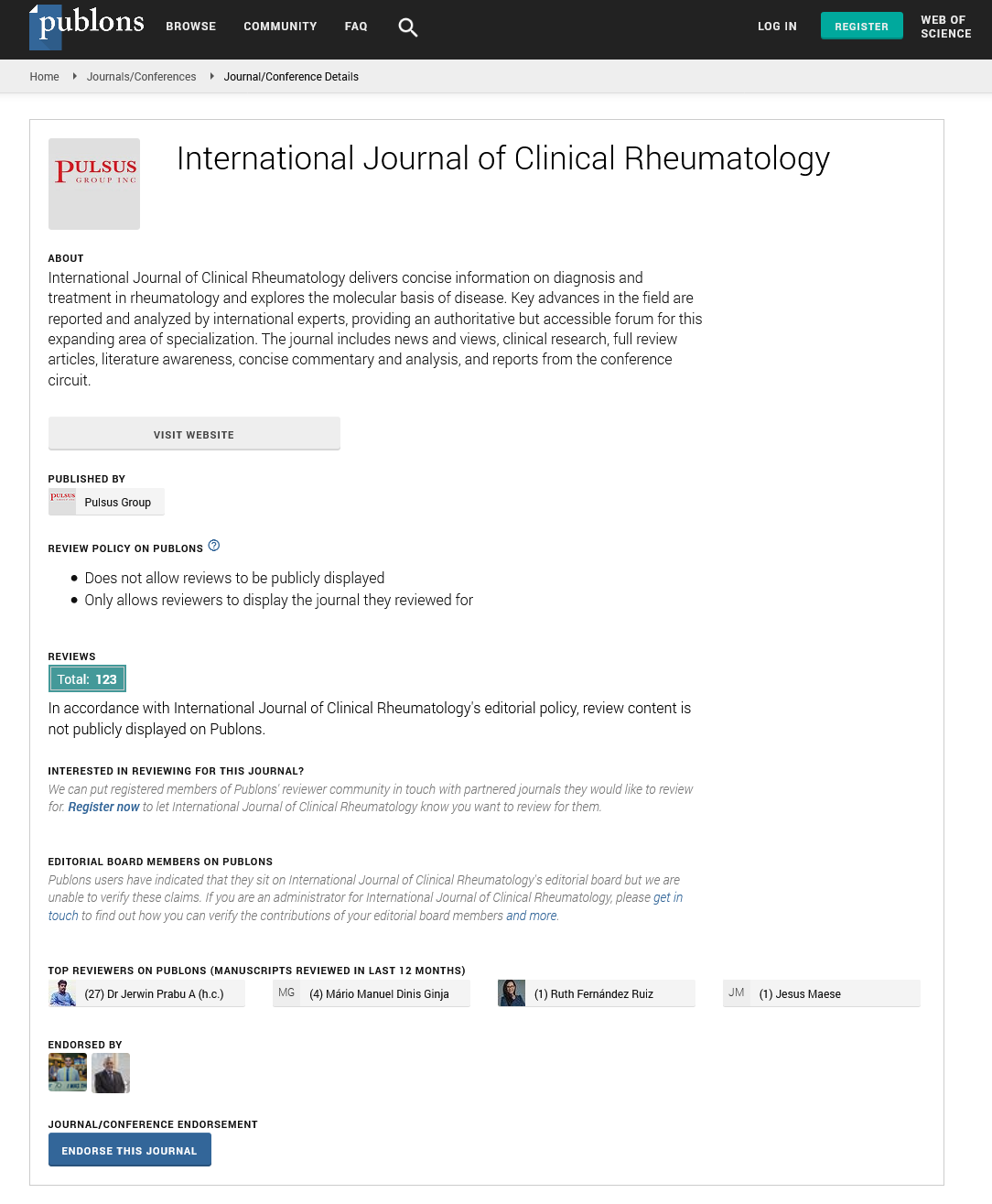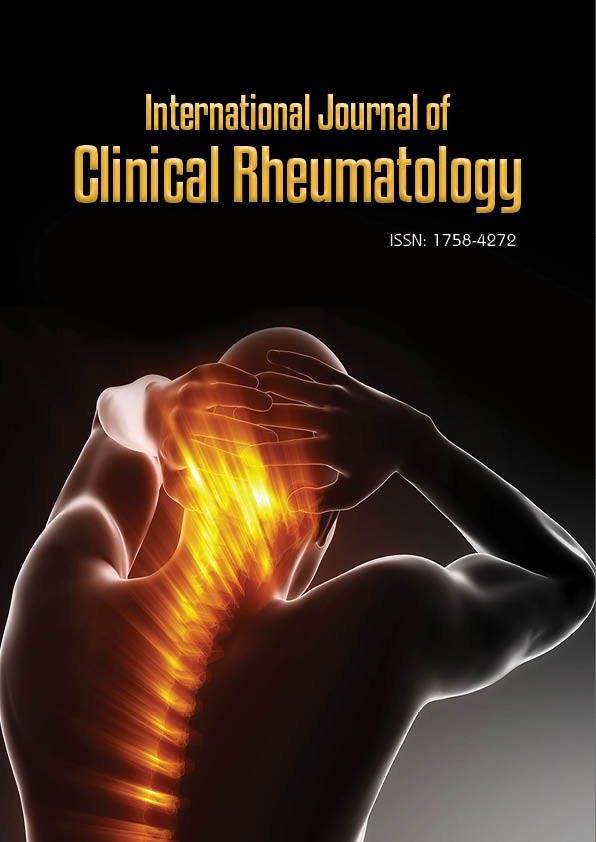Editorial - International Journal of Clinical Rheumatology (2025) Volume 20, Issue 1
Biologic Therapies in Ankylosing Spondylitis: Efficacy and Safety Profile
Noah King*
Department of Internal Medicine, Faculty of Medicine, University of Indonesia, Jakarta, Indonesia
- *Corresponding Author:
- Noah King
Department of Internal Medicine, Faculty of Medicine, University of Indonesia, Jakarta, Indonesia
E-mail: noah.king32@icloud.com
Received: 02-Jan-2025, Manuscript No. fmijcr-25-162967; Editor assigned: 04- Jan-2025, Pre-QC No. fmijcr-25-162967 (PQ); Reviewed: 18-Jan-2025, QC No. fmijcr-25-162967; Revised: 23-Jan-2025, Manuscript No. fmijcr-25-162967 (R); Published: 30-Jan-2025, DOI: 10.37532/1758- 4272.2025.20(1).380-382
Abstract
Ankylosing spondylitis (AS) is a chronic inflammatory disease primarily affecting the spine and sacroiliac joints. It often leads to progressive spinal fusion and severe disability if left untreated. Biologic therapies, particularly tumor necrosis factor (TNF) inhibitors and interleukin-17 (IL-17) inhibitors, have revolutionized the treatment landscape of AS. This article reviews the efficacy and safety of these biologic therapies and explores emerging treatment strategies for patients who do not respond to standard biologic treatments.
Keywords
Ankylosing spondylitis (as) • Biologic therapies • Tumor necrosis factor inhibitors (TNF inhibitors) • Etanercept • Infliximab • Adalimumab • Interleukin-17 (il-17) inhibitors • Secukinumab
Introduction
Ankylosing spondylitis (AS) is a debilitating condition that can result in significant loss of mobility and quality of life due to spinal inflammation and fusion. Biologic therapies, especially TNF inhibitors like etanercept, infliximab, and adalimumab, have been the cornerstone of treatment for AS patients who fail to respond to conventional therapies such as non-steroidal anti-inflammatory drugs (NSAIDs) and disease-modifying anti-rheumatic drugs (DMARDs). Recently, interleukin-17 (IL-17) inhibitors such as secukinumab have shown promising results in treating AS, providing patients with an alternative therapeutic option [1-3].
TNF Inhibitors and their efficacy in ankylosing spondylitis
Tumor necrosis factor (TNF) inhibitors, such as etanercept, infliximab, and adalimumab, have been the cornerstone of biologic treatment for AS. TNF is a pro-inflammatory cytokine that plays a central role in the pathogenesis of AS by promoting inflammation and joint destruction. TNF inhibitors target and neutralize TNF, thereby reducing inflammation and preventing further joint damage. Clinical studies have shown that TNF inhibitors significantly improve disease activity, spinal mobility, and overall quality of life for patients with AS. These medications have been shown to reduce spinal inflammation, alleviate pain, and prevent long-term disability. In patients who do not respond to NSAIDs or conventional DMARDs, TNF inhibitors have proven to be an effective and well-tolerated treatment option [4,5].
IL-17 Inhibitors: An Alternative to TNF Inhibitors
For patients who do not respond adequately to TNF inhibitors or those who experience side effects, interleukin-17 (IL-17) inhibitors offer a promising alternative. IL-17 is a pro-inflammatory cytokine involved in the pathogenesis of AS. Secukinumab, a monoclonal antibody that inhibits IL-17A, has demonstrated efficacy in clinical trials for patients with active AS. IL-17 inhibitors work by suppressing the inflammatory pathways driven by IL-17, resulting in decreased disease activity and improvement in symptoms. Secukinumab has shown comparable efficacy to TNF inhibitors in reducing disease activity, spinal inflammation, and improving functional status in patients with AS.
Safety profile of biologic therapies in ankylosing spondylitis
While biologic therapies offer significant benefits, they are not without risks. The most common side effects of TNF inhibitors and IL-17 inhibitors include an increased risk of infections, such as respiratory tract infections and tuberculosis. Patients receiving biologic therapy should be carefully screened for latent infections before starting treatment. Long-term use of biologics can also increase the risk of malignancies and cardiovascular events. However, the overall safety profile of biologics is generally favorable, and the benefits often outweigh the risks for patients with severe AS who are refractory to conventional treatments [6-9].
Challenges and Future Directions
Despite the effectiveness of biologic therapies, challenges remain in managing AS. A subset of patients does not respond to biologics, and identifying biomarkers to predict treatment response is an ongoing area of research. Additionally, newer treatments such as Janus kinase (JAK) inhibitors are being explored as potential alternatives for patients with refractory disease. Efficacy of Biologic Therapies: TNF inhibitors have been extensively studied and have shown a significant reduction in disease activity, inflammation, and pain in patients with AS. In clinical trials, TNF inhibitors have been associated with improved spinal mobility, decreased axial symptoms, and increased quality of life. For patients with severe disease or those who do not respond adequately to TNF inhibitors, IL-17 inhibitors offer an alternative. Secukinumab, a monoclonal antibody that targets IL-17A, has demonstrated remarkable efficacy in reducing disease activity, improving physical function, and achieving a higher rate of remission compared to conventional therapies. While biologic therapies are generally well tolerated, they are not without risks. Long-term use of TNF inhibitors has been associated with an increased risk of infections, particularly upper respiratory infections and tuberculosis. Additionally, TNF inhibitors may have an impact on cardiovascular health, raising concerns about their safety in patients with comorbidities. IL-17 inhibitors, though less commonly associated with infections, may still pose a risk for fungal infections and other opportunistic pathogens. Close monitoring for adverse events is essential to minimize the risks associated with biologic therapies. One of the challenges in AS treatment is the lack of response to biologics in a subset of patients. These non-responders present a significant clinical challenge, and ongoing research is focused on identifying biomarkers that can predict which patients will benefit from specific biologic therapies. Additionally, newer biologic agents such as JAK inhibitors (e.g., tofacitinib) are being explored in clinical trials as potential alternatives for patients with refractory AS [10].
Conclusion
Biologic therapies, including TNF inhibitors and IL-17 inhibitors, have transformed the management of ankylosing spondylitis, offering substantial improvement in disease outcomes and quality of life for many patients. Despite their effectiveness, the safety profile of these therapies requires careful consideration, especially in long-term use. Ongoing research into non-responder populations and novel biologic agents will continue to shape the future treatment landscape of AS.
References
- Fagugli P, Patera F, Battistoni S et al. Six-year single-center survey on AKI requiring renal replacement therapy: epidemiology and health care organization aspects. J Nephrol. 28, 339-349 (2015).
- Yokota LG, Sampaio BM, Rocha E et al. Acute kidney injury in elderly intensive care patients from a developing country: clinical features and outcome. Int J Nephrol Renovasc Dis. 10, 27-33 (2017).
- AlSawaftah N, Pitt WG, Husseini GA et al. Dual-Targeting and Stimuli-Triggered Liposomal Drug Delivery in Cancer Treatment. ACS Pharmacol Transl Sci. 4, 1028-1049 (2021).
- Rodrigues FB.Endovascualar treatment versus medical care alone for ischemic stroke: a systemic review and meta-analysis. BMJ. 57, 749-757 (2016).
- Jackson, Peter. The multiple ontologies of freshness in the UK and Portuguese agri food sectors. Trans Inst Br Geogr. 44, 79-93 (2019).
- Salinet ASM. Do acute stroke patients develop hypocapnia? A systematic review and meta-analysis. J Neurol Sci. 15, 1005-1010 (2019).
- Lewis RJ, Dutertre S, Vetter I et al. Conus venom peptide pharmacology. Pharmacological Reviews. 64, 259-98 (2012).
- Sankarasubbaiyan S, Janardan JD, Kaur P et al. Outcomes and characteristics of intermittent hemodialysis for acute kidney injury in an intensive care unit. Indian J Nephrol. 23, 30-33 (2013).
- Sharma NK, Das SK, Mondal AK et al. Endoplasmic reticulum stress markers are associated with obesity in nondiabetic subjects. J Clin Endocr. 93, 4532-4541 (2008).
- Zoccali C. Traditional and emerging cardiovascular and renal risk factors: an epidemiologic perspective. Kidney Int. 70, 26-33 (2006).
Indexed at, Google Scholar, Crossref
Indexed at, Google Scholar, Crossref
Indexed at, Google Scholar, Crossref
Indexed at, Google Scholar, Crossref
Indexed at, Google Scholar, Crossref
Indexed at, Google Scholar, Crossref
Indexed at, Google Scholar, Crossref
Google Scholar, Crossref, Indexed at
Indexed at, Google Scholar, Crossref


